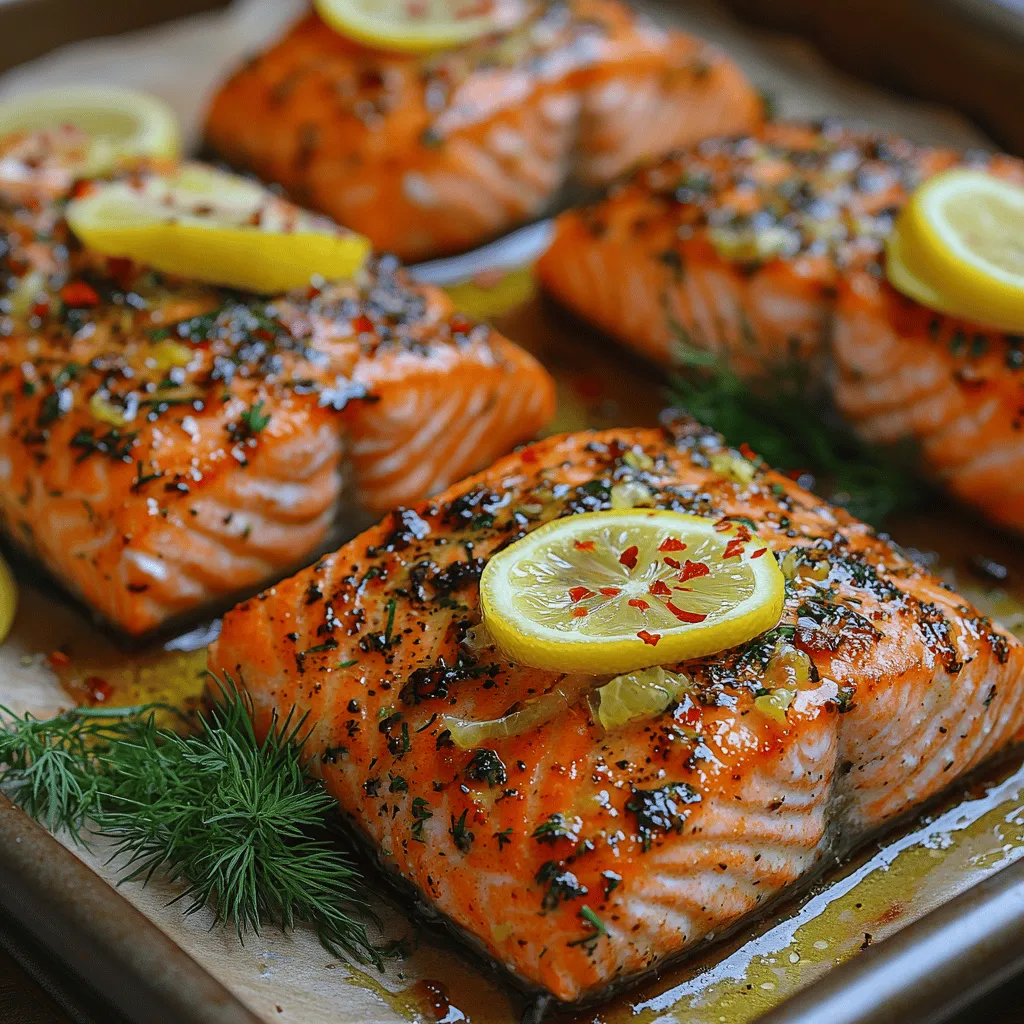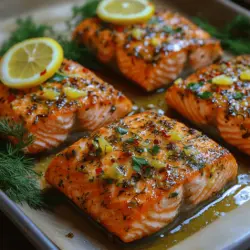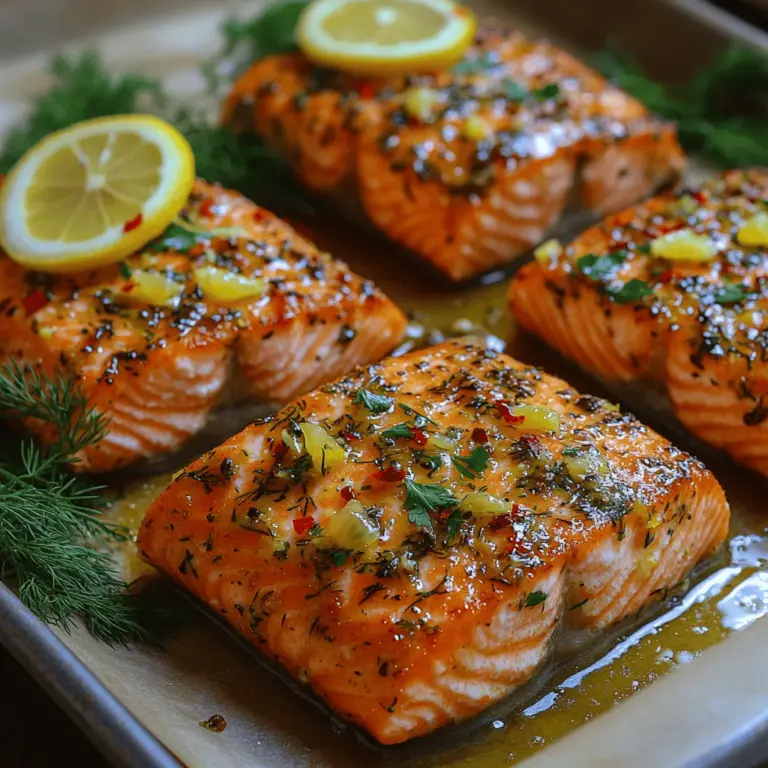Introduction
The Zesty Lemon Herb Salmon Bake is more than just a dish; it’s a celebration of fresh ingredients and vibrant flavors that embody the essence of home cooking. Salmon, a staple in many cuisines, has roots that trace back centuries. Its versatility has made it a favorite among chefs and home cooks alike. Originating from the cold waters of the North Atlantic and Pacific Oceans, salmon is not only delicious but also packed with nutrients, making it a go-to choice for health-conscious diners.
This recipe stands out for its simplicity and the delightful combination of zesty lemon and fragrant herbs. The tangy brightness of lemon perfectly complements the rich, buttery flavor of salmon, while the herbs add depth and earthiness. This dish is not just easy to prepare; it brings a touch of sophistication to any dinner table, making it ideal for weeknight meals or special occasions alike.
In this article, readers can expect a comprehensive guide to creating the perfect Zesty Lemon Herb Salmon Bake. We will delve into the ingredients that make this recipe shine, explore preparation steps, and highlight essential cooking techniques. By the end, you’ll have all the knowledge you need to impress your family and friends with this delicious dish.
Understanding the Ingredients
Overview of Key Ingredients
To create a memorable Zesty Lemon Herb Salmon Bake, it’s crucial to choose high-quality ingredients. The star of this dish is, of course, the salmon. Fresh salmon fillets are preferred for their tender texture and rich flavor. Look for wild-caught varieties when possible, as they tend to have a more robust taste and are generally considered more sustainable than farmed options.
Fresh Vegetables and Their Benefits
Accompanying the salmon, a medley of fresh vegetables adds both color and nutrition to the dish. Common choices include asparagus, bell peppers, and cherry tomatoes. These vegetables not only enhance the visual appeal but also provide a wealth of vitamins, minerals, and antioxidants. For instance, asparagus is rich in vitamins A, C, and E, while bell peppers are packed with vitamin C and fiber. Including a variety of vegetables not only boosts the dish’s health profile but also adds layers of flavor and texture.
Protein Options: Meat, Seafood, or Plant-Based Alternatives
While salmon is the traditional choice for this recipe, it can be adapted to suit various dietary preferences. For those seeking alternative proteins, consider using other types of fish, such as trout or cod, which can be prepared in the same manner. For a plant-based option, tofu or tempeh can be marinated and baked alongside the vegetables, absorbing the zesty lemon and herb flavors beautifully.
Essential Spices and Herbs
The flavor profile of this dish is elevated by a carefully curated selection of spices and herbs. Fresh herbs like parsley, dill, or basil can be used to infuse the salmon with aromatic qualities that complement the citrus. Additionally, spices such as garlic powder, onion powder, and black pepper enhance the overall taste without overwhelming the dish. Using fresh herbs whenever possible will provide a more vibrant flavor and fragrance compared to dried herbs.
Importance of Ingredient Quality and Sourcing
The quality of your ingredients can make all the difference in the final result. When sourcing your salmon, look for fillets that are firm to the touch with a bright color and a fresh smell. Vegetables should be crisp and vibrant, indicating freshness. Supporting local farmers’ markets or trusted grocery stores can often yield better quality produce and fish. By prioritizing the sourcing of your ingredients, you not only enhance the flavor of your dish but also contribute to sustainable practices.
Preparation Steps
Detailed Preparation Methods
Preparation is key to a successful cooking experience, and the Zesty Lemon Herb Salmon Bake is no exception. Begin by gathering all necessary ingredients and tools. This not only streamlines the cooking process but also ensures that you have everything on hand when you need it.
Washing and Chopping Vegetables
Start with washing your vegetables thoroughly to remove any dirt or pesticides. This step is crucial for both hygiene and flavor. After washing, chop the vegetables into uniform pieces to ensure even cooking. For example, asparagus can be trimmed to about 2-3 inches in length, while bell peppers should be sliced into strips or bite-sized pieces. This uniformity will help them cook at the same rate, resulting in perfectly tender vegetables.
Marinating Proteins: Techniques and Timing
Marinating your salmon is an essential step that infuses it with flavor and moisture. A simple marinade can be made from fresh lemon juice, olive oil, minced garlic, and your choice of herbs. Combine these ingredients in a bowl, and place the salmon fillets in the marinade, ensuring they are well coated. Allow the salmon to marinate for at least 30 minutes, but for optimal flavor, aim for 1-2 hours. If you’re using plant-based proteins, the same marinade can be applied to tofu or tempeh, allowing them to absorb the flavors.
Preparing Spices and Herbs for Maximum Flavor
While your salmon is marinating, prepare your spices and herbs. If using fresh herbs, chop them finely to release their essential oils, enhancing their flavor. For dried spices, consider toasting them in a dry skillet for a few minutes to intensify their aroma. This step is particularly effective for spices like cumin or coriander. By taking the time to prepare your spices and herbs thoughtfully, you will elevate the dish’s overall flavor profile.
Importance of Mise en Place in Cooking
Mise en place, a French culinary phrase meaning “everything in its place,” is a fundamental principle in cooking that emphasizes organization. Before you start cooking, arrange all your ingredients within reach, including the marinated salmon, chopped vegetables, and spices. This practice not only saves time but also reduces the likelihood of forgetting ingredients or steps in the cooking process. With everything prepared and ready, you can focus on executing the recipe with confidence and ease.
Cooking Techniques
Overview of Cooking Methods Suitable for the Dish
The Zesty Lemon Herb Salmon Bake can be prepared using various cooking methods, each imparting its unique qualities to the dish. The most common techniques include baking, roasting, and sautéing, all of which allow for the flavors to meld beautifully.
Sautéing: Tips for Perfect Texture and Flavor
Sautéing is a quick cooking method that involves cooking food in a small amount of fat over high heat. When preparing the vegetables for this dish, sautéing them can enhance their natural sweetness and create a slightly caramelized exterior. To achieve the best results, heat a tablespoon of olive oil in a skillet until hot, then add the vegetables in batches to avoid overcrowding. Sauté them just until tender but still vibrant, about 3-5 minutes, depending on the vegetable. This technique allows the vegetables to retain their crunch while developing a rich flavor.
Baking or Roasting: When to Use These Methods
Baking is the primary cooking method for this recipe. It allows for even cooking and helps the salmon retain its moisture. Preheat the oven to 375°F (190°C) and prepare a baking dish by lightly greasing it with olive oil or lining it with parchment paper. Place the marinated salmon fillets in the dish, surround them with the sautéed vegetables, and drizzle any remaining marinade over the top. Baking typically takes about 15-20 minutes, depending on the thickness of the salmon fillets.
Roasting, on the other hand, involves cooking at a higher temperature, resulting in a slightly charred and crisp exterior. If you prefer a roasted finish, increase the oven temperature to 425°F (220°C) and roast the dish for a similar amount of time. This method is perfect for achieving a delightful contrast between the tender salmon and crispy edges.
Simmering or Boiling: Achieving the Right Consistency
While not commonly used for salmon bakes, simmering can be employed when preparing sauces or braising vegetables to accompany the dish. A light lemon sauce can be simmered using the marinade ingredients, allowing the flavors to meld and thicken slightly. This sauce can then be drizzled over the baked salmon and vegetables before serving, adding an extra layer of zesty flavor.
Importance of Cooking Times and Temperature Control
Controlling cooking times and temperatures is vital for ensuring perfectly cooked salmon. Overcooking can lead to dry, tough fish, while undercooked salmon may not be safe to eat. A good rule of thumb is to cook salmon until it reaches an internal temperature of 145°F (63°C), at which point it should be opaque and easily flake with a fork. Investing in a reliable meat thermometer can help you achieve the perfect doneness every time.
By following these preparation steps and cooking techniques, you will be well on your way to creating a delectable Zesty Lemon Herb Salmon Bake that highlights the freshness of your ingredients and delivers a burst of flavor in every bite. Stay tuned for the next section, where we’ll break down the recipe into easy-to-follow steps.

Detailed Instructions for Each Phase of Cooking
Preparation of Ingredients
1. Preheat the Oven: Start by preheating your oven to 400°F (200°C). This ensures the salmon cooks evenly and develops a lovely crust.
2. Prepare the Salmon: Rinse the salmon fillets under cold water and pat them dry with paper towels. This step is crucial for achieving a nice sear later on and ensuring that the herbs and spices adhere well to the fish.
3. Marinade Creation: In a small bowl, combine the olive oil, lemon juice, minced garlic, salt, and black pepper. Whisk them together until well blended. This marinade will infuse the fish with rich flavors.
4. Marinating the Salmon: Place the salmon fillets in a shallow dish or a resealable plastic bag and pour the marinade over them. Ensure all surfaces are well-coated. Let the salmon marinate for at least 30 minutes, but if time allows, marinating for up to two hours in the refrigerator will enhance the flavor.
Cooking Instructions
1. Prep the Baking Sheet: Line a baking sheet with parchment paper or lightly grease it with cooking spray. This will help prevent sticking and make cleanup easier.
2. Place the Salmon: After marinating, remove the salmon from the dish or bag and place the fillets skin-side down on the prepared baking sheet.
3. Add Herbs and Lemon Slices: Sprinkle the chopped fresh herbs—dill, parsley, and thyme—over the salmon. For added flavor, place thin slices of lemon on top of each fillet. This step not only enhances the taste but also makes for a beautiful presentation.
4. Bake the Salmon: Place the baking sheet in the preheated oven and bake for 15-20 minutes. The exact time will depend on the thickness of the fillets. For a general guideline, cook for about 4-6 minutes per half-inch of thickness.
5. Check for Doneness: The salmon is done when it flakes easily with a fork and has an internal temperature of 145°F (63°C). If you prefer a bit of crispness, you can broil the salmon for the last 2-3 minutes of cooking.
Timing Tips for Each Step
– Marinating: Aim for 30 minutes, but let it sit longer if possible to deepen the flavors.
– Baking: Keep a close eye on the salmon after the 15-minute mark. If you’re using a thicker cut, you may need to extend the baking time by a few minutes. An instant-read thermometer is your best friend here.
Visual Cues to Look for During Cooking
– Color Change: As the salmon cooks, it will change from a translucent pink to a more opaque color. This is a good indicator that it is nearing completion.
– Flaking: Test the salmon with a fork after 15 minutes. If it flakes easily, it’s done. If not, give it a couple more minutes.
– Herb Aroma: The fragrance of the herbs will fill your kitchen as the salmon bakes, providing an enticing cue that it’s nearly ready.
Suggestions for Ingredient Substitutions
– Salmon: If you’re not a fan of salmon, other fatty fish like trout or mackerel can work well. For a non-fish option, consider using firm tofu or chicken breast, adjusting the cooking time as necessary.
– Herbs: Fresh herbs can be substituted with dried herbs, but use about one-third of the amount since dried herbs are more potent. For example, if the recipe calls for 3 tablespoons of fresh herbs, use only 1 tablespoon of dried.
– Olive Oil: Substitute with avocado oil or melted coconut oil for a different flavor profile.
Serving Suggestions
Plating and Presentation
To make your Zesty Lemon Herb Salmon visually appealing, consider the following plating techniques:
– Garnish: After removing the salmon from the oven, garnish with additional fresh herbs and lemon wedges for a pop of color.
– Layering: Serve over a bed of sautéed spinach or quinoa for an attractive base. Arrange the fish slightly off-center on the plate.
Recommended Side Dishes and Accompaniments
– Vegetables: Roasted asparagus, green beans, or a colorful medley of bell peppers pairs beautifully with the salmon. The vibrant colors and fresh flavors complement the dish perfectly.
– Grains: Quinoa, couscous, or wild rice provide a hearty base that absorbs the flavors of the salmon and marinade.
– Salads: A simple arugula salad with a light vinaigrette adds a refreshing crunch and balances the richness of the fish.
Pairing Suggestions: Beverages that Complement the Dish
– Wine: A crisp white wine such as Sauvignon Blanc or a light Pinot Grigio enhances the citrus notes of the dish.
– Non-Alcoholic: Consider sparkling water infused with lemon or a refreshing herbal iced tea, which will complement the zesty flavors beautifully.
Nutritional Information
Breakdown of Nutritional Content
– Calories: One serving of Zesty Lemon Herb Salmon (approximately 4 ounces) contains around 250-300 calories, depending mainly on the amount of olive oil used.
– Macronutrients:
– Protein: 25-30 grams
– Fat: 15-20 grams (mostly healthy fats from salmon and olive oil)
– Carbohydrates: 0-5 grams
– Micronutrients: Salmon is rich in omega-3 fatty acids, vitamin D, selenium, and B vitamins, contributing to heart health and overall wellness.
Health Benefits of the Main Ingredients
– Salmon: High in omega-3 fatty acids, salmon supports cardiovascular health, brain function, and has anti-inflammatory properties.
– Lemon: Rich in vitamin C, lemons can boost the immune system and add antioxidant benefits.
– Herbs: Fresh herbs not only enhance flavor but also provide various vitamins and minerals, contributing to overall health.
Considerations for Special Diets
– Gluten-Free: This recipe is naturally gluten-free, making it suitable for those with gluten sensitivities.
– Paleo/Keto: High in protein and healthy fats, this dish fits well into both the paleo and ketogenic diets.
– Dairy-Free: The recipe contains no dairy, making it suitable for those following a dairy-free lifestyle.
Cultural Significance
Historical Background of the Dish
Baking fish with herbs and citrus is a culinary tradition that spans many cultures. The combination of fresh herbs, lemon, and fish is especially prevalent in Mediterranean cuisines, where ingredients are often celebrated for their simplicity and freshness.
Variations Across Different Cultures and Regions
– Mediterranean: In Mediterranean countries, you might find variations that include olives, capers, and different local herbs like oregano or basil.
– Asian: In Asian cuisine, similar preparations may include soy sauce or ginger, showcasing the versatility of fish as a key protein.
Personal Anecdotes or Stories Related to the Dish
Growing up, my family often prepared salmon on special occasions, celebrating our love for fresh ingredients and the joy of cooking together. The zesty lemon and herb flavors always brought a sense of freshness to our family gatherings, making it a cherished dish that holds many fond memories.
Storing and Reheating
Best Practices for Storing Leftovers
– Refrigeration: Store leftover salmon in an airtight container in the refrigerator for up to 3 days. To maintain flavor, it’s best to store it without the marinade.
– Freezing: If you need to keep it longer, wrap the salmon tightly in plastic wrap and then place it in a freezer bag. It can be frozen for up to 3 months.
Tips for Reheating Without Losing Flavor or Texture
– Oven Reheating: Preheat your oven to 350°F (175°C) and place the salmon on a baking sheet. Cover it loosely with foil to prevent drying out and heat for about 10-15 minutes until warmed through.
– Microwave: If you’re short on time, the microwave can be used, but be cautious. Heat on low power for 30-second intervals, checking frequently to avoid overcooking.
Creative Uses for Leftover Ingredients
– Salmon Salad: Flake leftover salmon and mix it with Greek yogurt, dill, and chopped celery for a delicious salmon salad that can be served on sandwiches or over greens.
– Quiche: Incorporate leftover salmon into a quiche with eggs, spinach, and cheese for a quick and nutritious meal.
Conclusion
The Zesty Lemon Herb Salmon Bake is not only a flavorful and healthy dish but also a versatile one that can be adapted to suit various dietary preferences and tastes. Its simplicity and elegance make it perfect for both weeknight dinners and special occasions.
Whether you choose to serve it alongside a fresh salad, vibrant vegetables, or grains, this dish is sure to impress. Don’t hesitate to explore and experiment with the ingredients, making this recipe your own. Cooking is a joyful experience, one that brings people together, and sharing meals crafted with love enhances our connections. So gather your ingredients, fire up the oven, and enjoy the delightful flavors and aromas of this zesty dish with family and friends.


